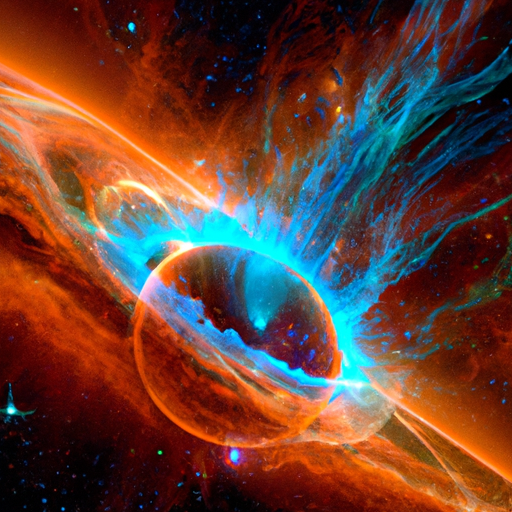In “The Search for Exoplanets: Cosmology’s Link to the Existence of Alien Worlds,” embark on a thrilling journey into the vast expanse of the universe as we explore the fascinating world of exoplanets. Discover how cosmology, the study of the origin and evolution of the universe, plays a crucial role in our quest to uncover the mysteries of these distant celestial bodies. From the formation of planetary systems to the revolutionary technological advancements enabling their detection, immerse yourself in the captivating realm of exoplanets and the profound implications they hold for the existence of alien worlds.

Introduction
Welcome to the fascinating world of exoplanets! In this article, we will delve into the concept of exoplanets, explore the field of cosmology, and uncover the profound implications that the discovery of these alien worlds has on our understanding of the universe. From the methods used to search for exoplanets to the technological advancements that enable us to explore beyond our own solar system, we will cover it all. So sit back, relax, and let’s embark on this cosmic journey together!
1. The Concept of Exoplanets
1.1 Definition of Exoplanets
Before we dive into the search for exoplanets, let’s start by understanding what exactly they are. Exoplanets, short for extrasolar planets, are planets that orbit stars outside of our own solar system. Unlike the familiar planets in our neighborhood, exoplanets reside in distant star systems, some even thousands of light-years away. These alien worlds come in all shapes and sizes, ranging from small rocky planets to gas giants larger than Jupiter.
1.2 Discovery of Exoplanets
The discovery of exoplanets is a relatively recent development in the field of astronomy. It was not until 1995 that the first confirmed exoplanet was discovered, orbiting a star similar to our Sun. This groundbreaking discovery was made using the radial velocity method, which we will explore in more detail later. Since then, the number of known exoplanets has skyrocketed, with thousands of alien worlds being detected through various observational techniques. Our understanding of exoplanets has expanded rapidly, revolutionizing our knowledge of the universe and our place within it.

2. Understanding Cosmology
2.1 Definition of Cosmology
To fully appreciate the significance of exoplanet discoveries, we must first grasp the concept of cosmology. Cosmology is the branch of astronomy that seeks to understand the origin, evolution, and structure of the universe as a whole. It encompasses a wide range of topics, from the Big Bang theory to the formation of galaxies and the existence of dark matter and dark energy. By studying cosmology, scientists are able to piece together the puzzle of how our universe came to be and how it continues to evolve.
2.2 The Study of the Universe
Cosmology relies on numerous observational and theoretical methods to unravel the mysteries of the universe. Astronomers use powerful telescopes and sophisticated instruments to observe the heavens, collecting data that allows them to investigate the fundamental properties of space, time, and matter. They analyze the light emitted by celestial objects, study the cosmic microwave background radiation, and explore the vast cosmic web of galaxies. Through these efforts, cosmologists aim to gain a deeper understanding of the universe’s past, present, and future.
3. The Search for Exoplanets
3.1 Methods and Techniques
Discovering exoplanets is no easy task, considering the vast distances and faint signals involved. Scientists employ several different methods and techniques to detect these alien worlds, each with its own advantages and limitations. The most successful methods to date include the transit method, the radial velocity method, and the microlensing method. These approaches allow astronomers to detect the subtle signs of exoplanets, such as the dimming of a star’s light as a planet passes in front of it or the wobble induced by a planet’s gravitational pull on its host star.
3.2 Transiting Method
The transit method, also known as the transit photometry, relies on observing the slight decrease in a star’s brightness when a planet crosses in front of it. By carefully monitoring the brightness of a star over time, scientists can identify the periodic dips in brightness caused by the passage of an exoplanet. This method has been highly successful in detecting large numbers of exoplanets, particularly those that are closer in size to Earth.
3.3 Radial Velocity Method
The radial velocity method, also known as the Doppler spectroscopy or the wobble method, looks for the tiny shifts in a star’s spectrum caused by the gravitational tug of an orbiting exoplanet. As a planet orbits its host star, it causes the star to move slightly towards and away from us, resulting in a shift in the star’s spectral lines. By carefully analyzing these spectral shifts, astronomers can determine the presence and characteristics of the exoplanet.
3.4 Microlensing Method
The microlensing method takes advantage of the phenomenon of gravitational lensing to detect exoplanets. When a star with an exoplanet passes in front of a more distant star, the gravity of the foreground star acts as a lens, bending and magnifying the light from the background star. This temporary increase in brightness can reveal the presence of an exoplanet, even if the planet itself is not directly visible.

4. Implications of Exoplanet Discoveries
4.1 The Existence of Habitable Worlds
One of the most significant implications of exoplanet discoveries is the possibility of habitable worlds beyond our own. The identification of exoplanets within the so-called “habitable zone” – the region around a star where conditions may be suitable for liquid water to exist on a planet’s surface – raises the exciting prospect of finding other Earth-like planets capable of supporting life as we know it. Studying these potentially habitable exoplanets is crucial in our search for life elsewhere in the universe.
4.2 The Drake Equation
The discovery of exoplanets has also had a profound impact on the Drake Equation, a mathematical formula used to estimate the number of technologically advanced civilizations in our galaxy. By providing insights into the prevalence of exoplanets, their frequency of occurrence in habitable zones, and other key factors, scientists can refine their estimates of the likelihood of intelligent life elsewhere in the universe.
4.3 Search for Extraterrestrial Intelligence (SETI)
The existence of exoplanets has revitalized the search for extraterrestrial intelligence, known as SETI. With the realization that there are potentially countless habitable worlds scattered across the cosmos, scientists are intensifying their efforts to detect signs of intelligent life beyond Earth. This includes searching for artificial radio signals, analyzing planetary atmospheres for biosignatures, and exploring other innovative methods of communication with potential extraterrestrial civilizations.
5. Linking Cosmology with the Existence of Alien Worlds
5.1 Formation and Evolution of Exoplanets
Understanding the formation and evolution of exoplanets is an area where cosmology and the study of exoplanets intersect. Cosmologists and astrophysicists study the processes by which gas and dust in protoplanetary disks coalesce to form planets, both rocky and gaseous. They also investigate the various mechanisms through which exoplanets migrate within their planetary systems and the forces that shape their ultimate fates. By linking cosmological theories with observational data from exoplanet discoveries, scientists can gain a clearer picture of the complex processes that give rise to alien worlds.
5.2 The Impact on Our Understanding of the Universe
The existence of exoplanets has expanded our understanding of the universe in profound ways. By studying these alien worlds, scientists can gain insights into the diversity of planetary systems, the prevalence of different types of planets, and the factors that influence their habitability. These discoveries challenge our previously Earth-centric view of the cosmos and force us to acknowledge the vastness and complexity of the universe. The search for exoplanets has forever changed the way we perceive our place in the cosmos, inspiring awe and fueling curiosity about the possibilities that lie beyond our solar system.

6. Exoplanet Exploration Missions
6.1 Kepler Space Telescope
One of the most influential missions in the search for exoplanets was the Kepler Space Telescope. Launched by NASA in 2009, Kepler revolutionized our understanding of exoplanets by monitoring the brightness of over 150,000 stars, hunting for telltale signs of transiting exoplanets. Kepler’s discoveries include the identification of numerous exoplanets in the habitable zone, unveiling the sheer abundance and diversity of alien worlds in our galaxy.
6.2 Transiting Exoplanet Survey Satellite (TESS)
Building upon the success of Kepler, NASA’s Transiting Exoplanet Survey Satellite (TESS) has taken the search for exoplanets to the next level. Launched in 2018, TESS is scanning the entire sky for transiting exoplanets around the brightest stars. Its high-resolution images and wide-field cameras allow for the identification of exoplanets that are prime targets for further study. TESS promises to greatly expand our catalog of known exoplanets and provide valuable data for future missions, such as the James Webb Space Telescope.
6.3 James Webb Space Telescope (JWST)
Anticipation is mounting for the launch of the James Webb Space Telescope (JWST), the next flagship space observatory set to launch in late 2021. With its advanced capabilities, the JWST will enable scientists to study the atmospheres of exoplanets in unprecedented detail. By analyzing the light that passes through an exoplanet’s atmosphere during a transit, researchers hope to detect the chemical fingerprints of gases, potentially including signs of life. The JWST holds remarkable potential to deepen our understanding of exoplanets and open new frontiers in the search for habitable worlds.
7. Challenges in Exoplanet Research
7.1 Detection and Characterization
While we have made tremendous strides in exoplanet research, significant challenges still remain. The detection and characterization of exoplanets, especially those that closely resemble Earth, can be incredibly difficult due to their small sizes and dim signals. Overcoming these challenges requires advancements in technology and the development of innovative observational techniques.
7.2 Analyzing Exoplanet Atmospheres
Analyzing the atmospheres of exoplanets presents a unique set of challenges. Scientists strive to determine the composition of exoplanet atmospheres, search for potential biosignatures, and understand the atmospheric conditions that may affect a planet’s habitability. However, the faint glimmers of light from distant exoplanets are often obscured by the bright glare of their host stars, making detailed analysis a complex task.
7.3 Identifying Earth-like Exoplanets
Another challenge in exoplanet research is identifying truly Earth-like exoplanets. While the discovery of planets within the habitable zone is promising, many factors influence a planet’s potential for supporting life. These include factors like the presence of a protective atmosphere, the existence of liquid water, and the absence of detrimental factors like high levels of radiation. Determining the habitability of an exoplanet is a multifaceted endeavor that requires a comprehensive understanding of planetary science.

8. Future Prospects and Discoveries
8.1 Advancements in Technology
As technology continues to advance, the field of exoplanet research stands poised for exciting new discoveries. Revolutionary new telescopes, such as the Extremely Large Telescope (ELT) and the Nancy Grace Roman Space Telescope, will provide unprecedented observational capabilities. These and other upcoming missions will enable scientists to detect smaller and more distant exoplanets, capture high-resolution images, and study the atmospheres in greater detail. These advancements hold the potential to unveil even more extraordinary findings in the years to come.
8.2 The Search for Signs of Life
Perhaps the most compelling future prospect in exoplanet research is the search for signs of life beyond Earth. As our technology and understanding improve, scientists are inching closer to identifying biosignatures – chemical indicators in exoplanet atmospheres that could suggest the presence of life. Detecting signs of life, even microbial, on another world would be a groundbreaking discovery with profound implications for our understanding of the universe and our place within it.
8.3 Exploration Beyond Our Solar System
The discovery of exoplanets has ignited a spark of curiosity and exploration that extends beyond our own solar system. In the coming decades, there are plans for ambitious missions, such as the Breakthrough Starshot initiative, which aims to send tiny spacecraft to our nearest neighboring star system, Alpha Centauri. These future missions hold the promise of not only discovering new exoplanets but also exploring and potentially visiting these distant worlds. The search for exoplanets, therefore, serves as a stepping stone towards the exploration of the wider cosmos.
9. Ethical and Philosophical Implications
9.1 The Existence of Extraterrestrial Life
The discovery and potential confirmation of extraterrestrial life would not only revolutionize our scientific understanding but also raise profound ethical and philosophical questions. How would the existence of life elsewhere in the universe impact our perception of humanity’s uniqueness and place in the cosmos? Would the discovery of intelligent extraterrestrial civilizations alter our sense of purpose and the meaning we ascribe to our own existence? These contemplations highlight the far-reaching implications of exoplanet discoveries beyond the realm of science.
9.2 Impact on Humanity’s Place in the Universe
Exoplanet discoveries have already played a significant role in shifting our perspective on humanity’s place in the universe. The sheer number and diversity of exoplanets challenge the idea that Earth is a unique haven for life. As our understanding of the cosmos deepens, we may come to realize that our existence is not an anomaly but rather part of a much grander tapestry of life and evolution. This expanded awareness of our cosmic surroundings can be awe-inspiring, humbling, and thought-provoking, encouraging us to cherish our home planet and foster a sense of global interconnectedness.
In conclusion, the search for exoplanets has revolutionized our understanding of the universe and our place within it. From the discovery of alien worlds to the insights gained about the formation and evolution of planets, this remarkable field of study continues to uncover the mysteries of the cosmos. With advancements in technology and future missions on the horizon, we stand poised for even more astonishing discoveries that will shape our understanding of exoplanets and the potential for extraterrestrial life. So keep your eyes on the skies, for the universe has so much more to reveal!